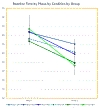Non-invasive cervical vagus nerve stimulation effects on reaction time and valence image anticipation response
- PMID: 35738468
- PMCID: PMC9721369
- DOI: 10.1016/j.brs.2022.06.006
Non-invasive cervical vagus nerve stimulation effects on reaction time and valence image anticipation response
Abstract
Background: Norepinephrine (NE) driven noninvasive vagus nerve stimulation (nVNS), which improves attention and reduces reaction time, augments learning. Equally important, endogenous NE mediated arousal is highly dependent on the valence (positive or negative) of the exogenous stimulus. But to date, no study has measured valence specific effects of nVNS on both functional magnetic resonance imaging (fMRI) anticipation task response and reaction time in healthy individuals. Therefore, the aim of this pilot study was to assess whether nVNS vs sham modulates valence cortical anticipation task response and reaction time in a normative sample.
Methods: Participants received right sided transcutaneous cervical nVNS (N = 12) or sham (N = 12) stimulation during a 3T fMRI scan. Subjects first performed a continuous performance task (CPT) and then a cued anticipation task to images of positively and negatively valenced events during fMRI. Reaction times to cues and Blood oxygen level dependent (BOLD) response were examined over phase to identify effects of nVNS/sham over time.
Results: nVNS reduced reaction time for all valenced image anticipation trials. With the fMRI anticipation task, we observed a valence-specific effect; nVNS increased responsivity to images with negative valence and decreased responsivity to images with positive valence, whereas sham showed an inverse valence response.
Conclusions: nVNS was linked to reduced reaction time during the anticipation task. In tandem, nVNS consistently enhanced responsivity to negatively valenced images and diminished responsivity to positively valenced images, suggesting specific nVNS driven endogenous neurotransmitter signaling may contribute.
Keywords: Anticipation; Arousal; Attention; Cervical noninvasive vagal nerve stimulation; Functional magnetic resonance imaging; Locus coeruleus; Norepinephrine.
Copyright © 2022. Published by Elsevier Inc.
Conflict of interest statement
Declaration of interests The authors declare that they have no known competing financial interests or personal relationships that could have appeared to influence the work reported in this paper.
Figures



Similar articles
-
Effects of Noninvasive Cervical Vagal Nerve Stimulation on Cognitive Performance But Not Brain Activation in Healthy Adults.Neuromodulation. 2022 Apr;25(3):424-432. doi: 10.1111/ner.13313. Neuromodulation. 2022. PMID: 35396072 Free PMC article.
-
Access to Vagal Projections via Cutaneous Electrical Stimulation of the Neck: fMRI Evidence in Healthy Humans.Brain Stimul. 2017 Jan-Feb;10(1):19-27. doi: 10.1016/j.brs.2016.10.008. Epub 2016 Oct 20. Brain Stimul. 2017. PMID: 28104084
-
CNS BOLD fMRI effects of sham-controlled transcutaneous electrical nerve stimulation in the left outer auditory canal - a pilot study.Brain Stimul. 2013 Sep;6(5):798-804. doi: 10.1016/j.brs.2013.01.011. Epub 2013 Feb 13. Brain Stimul. 2013. PMID: 23453934 Clinical Trial.
-
Update on noninvasive neuromodulation for migraine treatment-Vagus nerve stimulation.Prog Brain Res. 2020;255:249-274. doi: 10.1016/bs.pbr.2020.06.009. Epub 2020 Jul 6. Prog Brain Res. 2020. PMID: 33008508 Review.
-
Vagus nerve stimulation for primary headache disorders: An anatomical review to explain a clinical phenomenon.Cephalalgia. 2019 Aug;39(9):1180-1194. doi: 10.1177/0333102419833076. Epub 2019 Feb 20. Cephalalgia. 2019. PMID: 30786731 Free PMC article.
Cited by
-
A Prospect to Ameliorate Affective Symptoms and to Enhance Cognition in Long COVID Using Auricular Transcutaneous Vagus Nerve Stimulation.J Clin Med. 2023 Feb 2;12(3):1198. doi: 10.3390/jcm12031198. J Clin Med. 2023. PMID: 36769845 Free PMC article.
-
Effect of touch on proprioception: non-invasive trigeminal nerve stimulation suggests general arousal rather than tactile-proprioceptive integration.Front Hum Neurosci. 2024 Oct 14;18:1429843. doi: 10.3389/fnhum.2024.1429843. eCollection 2024. Front Hum Neurosci. 2024. PMID: 39469503 Free PMC article.
-
Transcutaneous cervical vagus nerve stimulation enhances second-language vocabulary acquisition while simultaneously mitigating fatigue and promoting focus.Sci Rep. 2024 Jul 26;14(1):17177. doi: 10.1038/s41598-024-68015-4. Sci Rep. 2024. PMID: 39060415 Free PMC article.
-
Transcutaneous Cervical Vagus Nerve Stimulation Improves Speech Comprehension in Noise: A Crossover, Placebo-Controlled Study.Neuromodulation. 2025 May 21:S1094-7159(25)00151-5. doi: 10.1016/j.neurom.2025.04.007. Online ahead of print. Neuromodulation. 2025. PMID: 40396942 Free PMC article.
-
Impact of transcutaneous vagus nerve stimulation on healthy cognitive and brain aging.Front Neurosci. 2023 Jul 28;17:1184051. doi: 10.3389/fnins.2023.1184051. eCollection 2023. Front Neurosci. 2023. PMID: 37575296 Free PMC article. Review.
References
-
- Frangos E, Komisaruk BR: Access to Vagal Projections via Cutaneous Electrical Stimulation of the Neck: fMRI Evidence in Healthy Humans. Brain Stimul 2017, 10(1):19–27. - PubMed
-
- McIntire L, Goodyear C, McKinley A: Peripheral Nerve Stimulation to Augment Human Analyst Performance. In: 2019. IEEE Research and Applications of Photonics in Defense Conference (RAPID): 2019: IEEE; 2019: 1–3.
-
- Fornai F, Ruffoli R, Giorgi FS, Paparelli A: The role of locus coeruleus in the antiepileptic activity induced by vagus nerve stimulation. European Journal of Neuroscience 2011, 33(12):2169–2178. - PubMed

